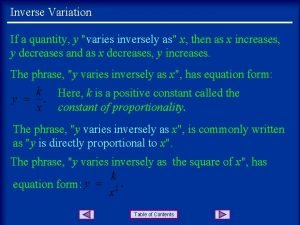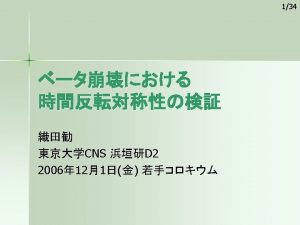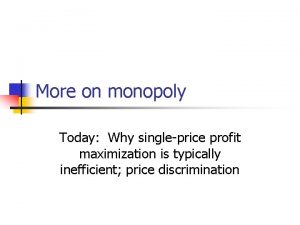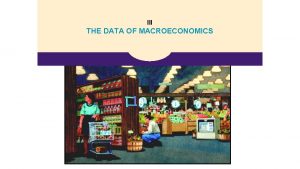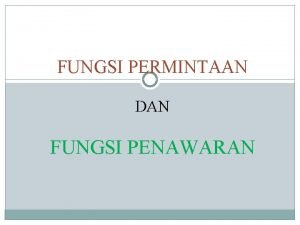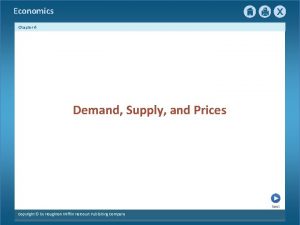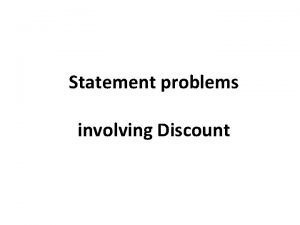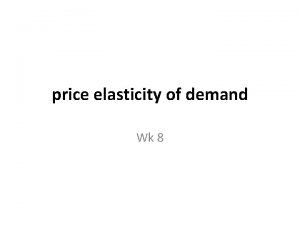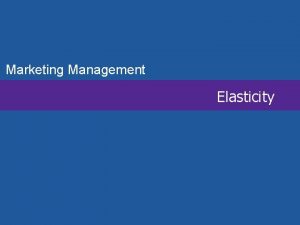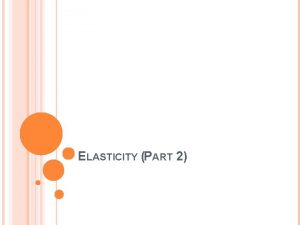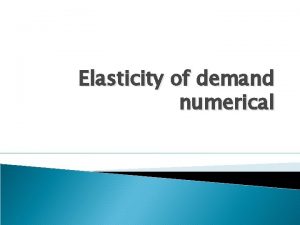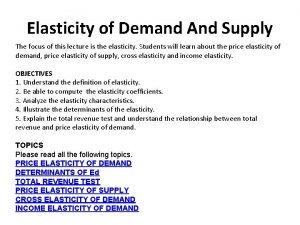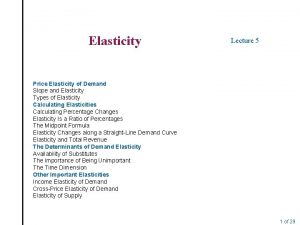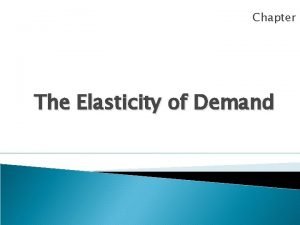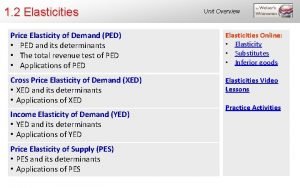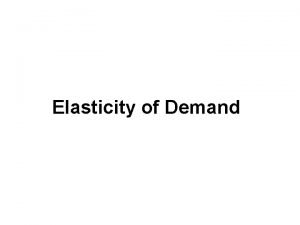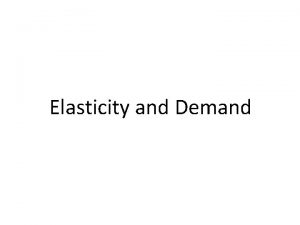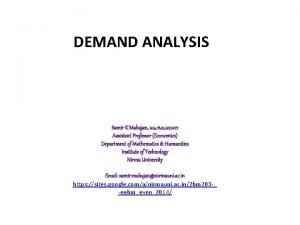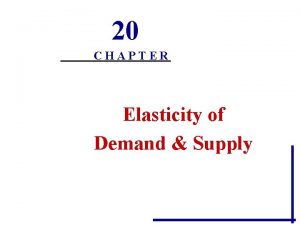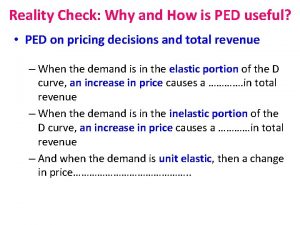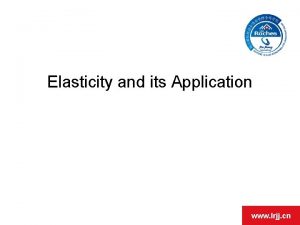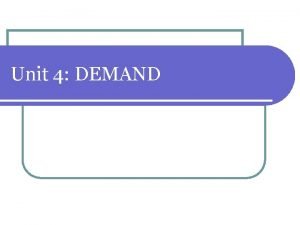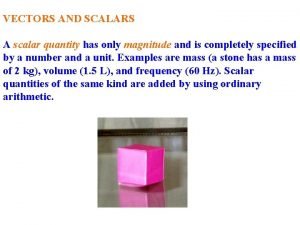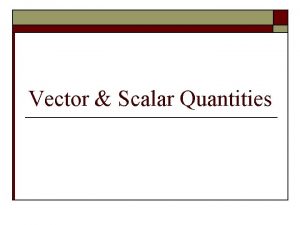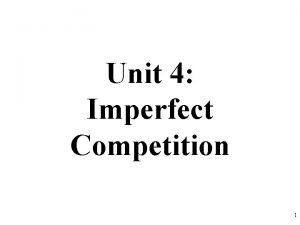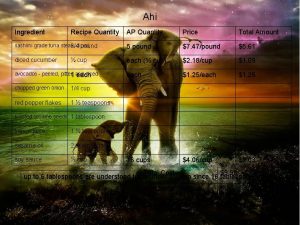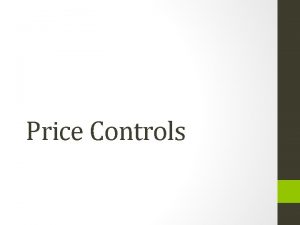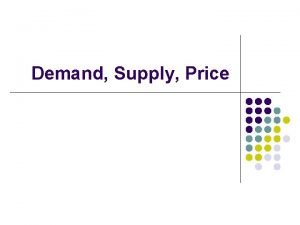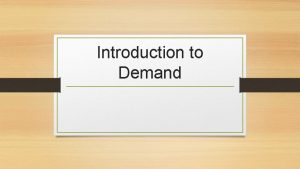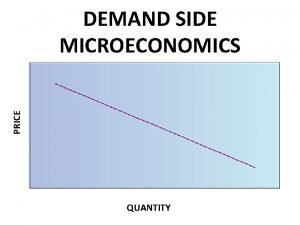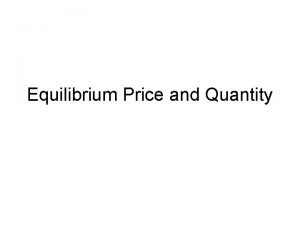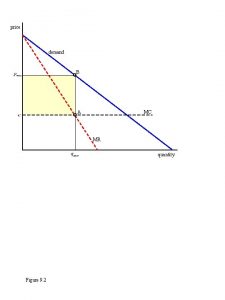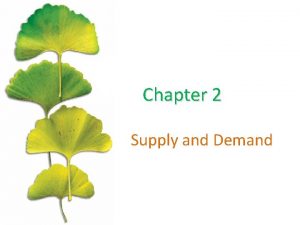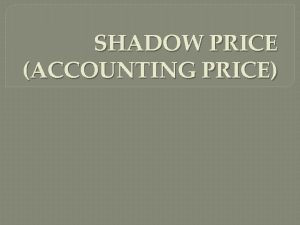Chapter 4 Demand Price Quantity Chapter 4 Demand















































- Slides: 47

Chapter 4 Demand Price Quantity

Chapter 4 Demand Price Students Will Know: ● ● ● Demand is the desire, ability, and willingness to buy a product or service The Law of Demand, which states that the quantity demanded of a product varies inversely with its price The difference between elastic and inelastic demand for a product Quantity

Chapter 4 Demand Price Students Will Be Able To: ● ● ● Explain how demand helps societies determine WHAT, HOW, and FOR WHOM to produce Paraphrase the Law of Demand Apply the total expenditures test to determine the elasticity of a product Quantity

Price Chapter 4 Demand Lesson 1 What is Demand? Quantity

Chapter 4 Demand Price Lesson 1 What is Demand? Students Will Know: ● ● Demand is the desire, ability, and willingness to buy a product or service The Law of Demand, which states that the quantity demanded of a product varies inversely with its price Quantity

Chapter 4 Demand Price Lesson 1 What is Demand? Students Will Be Able To: ● ● Name the variables that determine demand for a product Explain how demand helps societies determine WHAT, HOW, and FOR WHOM to produce Paraphrase the Law of Demand Interpret the significance of diminishing marginal utility on the price consumers are willing to pay for additional units of a product Quantity

What Is Demand? Demand for a product means more than simply the desire to own it.

What Is Demand? Demand for a product means more than simply the desire to own it. Demand includes desire, but also the willingness and ability to buy the product!

What Is Demand? Demand for a product means more than simply the desire to own it. Demand includes desire, but also the willingness and ability to buy the product!

What Is Demand? Demand for a product means more than simply the desire to own it. Demand includes desire, but also the willingness and ability to buy the product! ● Demand is central to the process of a society answering the basic economic questions: WHAT, HOW, and FOR WHOM to produce? ● The calculation of demand comes down to only two variables ○ The price of the product ○ The quantity available at a given point in time ● To keep things simple, economists employ a simple assumption called ceteris paribus ○ All other things held constant ○ Allows economist to focus on only one change at a time ■ If the price changes from $5 to $10, we evaluate only the effects of the change in price

What Is Demand? Demand Schedule Price Quantity $10 0 $9 0 $6 1 $4 2 $3 3 $2 4 Listing showing the quantity demanded at all possible prices that might prevail in the market at any given time.

What Is Demand? Demand Curve Demand Schedule Price Quantity $10 0 $9 0 $6 1 $4 2 $3 3 $2 4 Price $10 $ 9 $ 8 $ 7 $ 6 $ 5 $ 4 $ 3 $ 2 $ 1 1 2 3 4 5 6 Quantity

How do people react to a change in price of an item? How does this illustrate the concept of demand?

How do people react to a change in price of an item? How does this illustrate the concept of demand? People usually buy more if the price decreases or buy less if it increases. Demand is the desire, ability, and willingness to buy a product; all of these tend to increase as the price decreases. With few exceptions, desire and ability or willingness to buy a product decrease if the price increases.

What Is Demand? Look at Figure 4. 2 on page 104. Answer the “Critical Thinking” question. How does the market demand curve differ from an individual’s demand curve? The market demand curve shows the quantity demanded by everyone--in this case, Mike and Julia--for all prices that might prevail in a market at a specific time. Mike’s and Julia’s quantities demanded were added together for each price point.

How does the market demand curve reflect the Law of Demand?

How does the market demand curve reflect the Law of Demand? The market demand curve shows the quantity demanded by everyone who might want to purchase a product. It shows how the Law of Demand works in relation to prices and quantity purchased. The quantity demanded increases as the price decreases and the quantity demanded decreases as the price increases.

What Is Demand? Read the Biography of Carl Menger on page 105 and answer the “Critical Thinking” question. Carl Menger pioneered theory of marginal utility--that a good’s value and price are determined by how well it satisfies a consumer’s wants.

How does the principle of diminishing marginal utility explain the price we pay for another unit of a good or service?

How does the principle of diminishing marginal utility explain the price we pay for another unit of a good or service? As we consume more and more of something, we get less additional satisfaction out of each additional amount we consume. Getting less satisfaction decreases our willingness to pay as much for another unit.

Price Chapter 4 Demand Lesson 2 Factors Affecting Demand Quantity

Chapter 4 Demand Price Lesson 2 Factors Affecting Demand Students Will Know: ● ● Only a change in price can cause a change in quantity demanded The factors that cause a shift in demand include consumer tastes, substitutes, complements, expectations, and the number of consumers Quantity

Chapter 4 Demand Price Lesson 2 Factors Affecting Demand Students Be Able To: ● ● ● Specify the factor that causes a change in quantity demanded Explain how the income and substitution effects change quantity demanded List non-price factors that affect demand Quantity

Factors Affecting Demand for many products and services changes constantly. ● What factors in your own life have an effect on your interest in acquiring a particular product? ● A Change in the Quantity Demanded ○ Graphically represented as a movement along the existing demand curve. ■ As price increases, the quantity demanded decreases or moves left along the demand curve. ■ As price decreases, the quantity demanded increases or moves right along the demand curve.

Factors Affecting The Quantity Demanded Price A A move along the demand curve from point A to point B represents an increase in the quantity demanded caused by a decrease in price B Quantity

Factors Affecting The Quantity Demanded Price A A move along the demand curve from point B to point A represents a decrease in the quantity demanded caused by an increase in price B Quantity

Factors Affecting The Quantity Demanded The Income Effect -- A change in quantity demanded because of a change in price that alters consumers’ income. Price ● ● A B Quantity If the price of an item decreases the consumer feels “richer” because their dollar will buy more. If the price of an item increases the consumer feels “poorer” because their dollar will buy less.

Factors Affecting The Quantity Demanded The Substitution Effect -- A change in quantity demanded because of a shift in relative prices Price ● A ● B Quantity If the price of an item increases the quantity demanded will decrease because consumers will select a comparable item that is less expensive. If the price of an item decreases the quantity demanded will increase because consumers will select that item because its price is lower than another item

Factors Affecting The Quantity Demanded Price Whenever a price change causes a change in quantity demanded, it will be indicated by a movement along the existing demand curve. Whether the quantity demanded increases or decreases because of a price change, the demand curve itself does not shift. A B Quantity

Factors Affecting A Change In Demand Price Factors, other than price, will cause the demand for an item to change. Quantity

Factors Affecting A Change In Demand Price Factors, other than price, will cause the demand for an item to change. Quantity A Change In Demand -- the quantity demanded at each and every price level changes causing a new curve to drawn to the left or to the right ● A shift of the demand curve to the left indicates a decrease in demand (decrease in the quantity demanded at each and every price level) ● A shift of the demand curve to the right indicates an increase in demand (increase in the quantity demanded at each and every price level)

Factors Affecting A Change In Demand Price Consumer Income -- When people’s income changes the consumer demand for an item will change ● ● Quantity When people earn more, they are willing and able to buy more at different price levels causing the demand curve to shift to the right. When people earn less, they are willing and able to buy less at different price levels causing the demand curve to shift to the left.

Factors Affecting A Change In Demand Price Consumer Taste -- People often change their minds about which products to buy. ● ● ● Quantity Advertising, fashion trends, peer group pressure, and even changes in seasons can affect consumer choice. A successful advertising campaign can increase an item’s popularity causing more consumers to be willing to buy that item. This would cause an increase in demand for that item. If people have reasons to worry about the quality or safety of an item, consumers will be less willing to buy that item. This would cause a decrease in demand for that item.

Factors Affecting A Change In Demand Price Substitutes -- competing products that can be used in place of one another ● ● Quantity An increase in the price of one item will cause an increase in the demand for a substitute. A decrease in the price of one item will cause a decrease in the demand for a substitute.

Factors Affecting A Change In Demand Price Complements -- the use of one product increases the use of the other ● ● Quantity An increase in the price of one item will cause a decrease in the demand for a complement. A decrease in the price of one item will cause an increase in the demand for a complement.

Factors Affecting A Change In Demand Price Expectations -- The way people think about the future affects demand for a product ● ● Quantity A positive expectation about a product -- decrease in price, increase in quality, new model, etc. -- will decrease demand for that item today. A negative expectation about a product -- increase in price, decrease in quantity, etc. -- will increase demand for that item today.

Factors Affecting A Change In Demand Price Number of Consumers -- When more consumers enter the market, market demand increases ● ● Quantity A change in income, tastes, expectations, and prices or related products affects individual demand schedules and curves--and hence the market demand curve. The market demand curve will also change if there is a change in the number of consumers.

Chapter 4 Demand Lesson 3 Elasticity of Demand Price Quantity

Chapter 4 Price Demand Lesson 3 Elasticity of Demand Students Will Know: ● ● The difference between elastic demand inelastic demand for a product The determinants of demand elasticity Quantity

Chapter 4 Price Demand Lesson 3 Elasticity of Demand Students Will Be Able To: ● ● ● Summarize three causes of demand elasticity Apply the total expenditures test to determine the elasticity of a product Identify determinants of demand elasticity Quantity

Elasticity of Demand Elasticity is a measure of responsiveness that describes the way a dependent variable changes in response to a change in an independent variable. ● In economics, price is almost always the independent variable ● Price is the variable that causes the quantity demanded to change ● Demand Elasticity -- The extent to which a change in price causes a change in the quantity demanded.

Elasticity of Demand ○ ELASTIC DEMAND -- When a change in price causes a relatively larger change in quantity demanded ■ Look at Panel A of Figure 4. 5 on page 116 ■ As we move from point a to point b, we see that price declines by one-third, or from $3 to $2 ■ At the same time, the quantity demanded doubles from two to four units ■ Because the percentage change in quantity demanded is relatively larger than the percentage change in price, demand between those two points is elastic ■ If the price increases, consumers are more willing to buy a substitute

Elasticity of Demand ○ INELASTIC DEMAND -- When a change in price causes a relatively smaller change in quantity demanded ■ Look at Panel B of Figure 4. 5 on page 116 ■ As we move from point a to point b, we see that price declines by one-third, or from $3 to $2 ■ At the same time, the quantity demanded increases by only 25% ■ Because the percentage change in quantity demanded is relatively smaller than the percentage change in price, demand between those two points is inelastic ■ If the price increases, many consumers are still willing to buy the same product, only a few buy a substitute

Elasticity of Demand ○ UNIT ELASTIC DEMAND -- When a change in price causes a proportional change in quantity demanded ■ Look at Panel C of Figure 4. 5 on page 116 ■ As we move from point a to point b, we see that price declines by one-third, or from $3 to $2 ■ At the same time, the quantity demanded increases by onethird ■ Because the percentage change in quantity demanded is proportional to the percentage change in price, demand between those two points is unit elastic ■ Unit elastic is like a middle ground that separates the other two categories of price elasticity of demand: elastic and inelastic

Elasticity of Demand ○ What is the difference between elastic and inelastic demand? ■ Elastic demand means that a change in price of something like a food item causes a significant change in quantity demanded ■ Inelastic demand means that a change in price of something like medicine has a relatively small effect on quantity demanded

Elasticity of Demand ○ Expenditures Test ■ We find total expenditures (or total revenue) by multiplying the price of a product by the quantity demanded for any point along the demand curve ■ Elastic Demand -- a change in price and a change in revenue move in opposite directions ■ Inelastic Demand -- a change in price and a change in revenue move in the same direction ■ Unit Elastic Demand -- there is no change in revenue regardless of the change in price

Elasticity of Demand ○ Determinants of Demand Elasticity ■ Can the purchase be delayed? ● If yes, the product is elastic ● If no, the product is inelastic ■ Are Adequate Substitutes Available? ● If yes, the product is elastic ● If no, the product is inelastic ■ Does the Purchase Use a Large Portion of Income? ● If yes, the product tends to be elastic ● If no, the product tends to be inelastic ■ The answer to these questions is not always yes or no. Example: the demand for the services of medical doctors tends to be inelastic, even though they tend to require a large portion of people’s income. This is because most people prefer to receive medical care right away and from a particular provider rather than taking the time to look for adequate substitutes.
 Price ceiling at price floor kahulugan
Price ceiling at price floor kahulugan Vector and scalar quantities
Vector and scalar quantities Vector and scalar quantities
Vector and scalar quantities Is magnitude scalar or vector
Is magnitude scalar or vector Quantity y varies inversely as quantity x.
Quantity y varies inversely as quantity x. Scalar quantity and vector quantity
Scalar quantity and vector quantity Monopolist profit maximizing price and quantity
Monopolist profit maximizing price and quantity How to calculate real gdp from price and quantity
How to calculate real gdp from price and quantity Fungsi permintaan rumus
Fungsi permintaan rumus Chapter 6 section 2 supply and demand in everyday life
Chapter 6 section 2 supply and demand in everyday life Marked price-selling price=
Marked price-selling price= Features of installment purchase system
Features of installment purchase system 7 step sourcing methodology
7 step sourcing methodology Price discovery and price determination
Price discovery and price determination Cross-price elasticity of demand formula
Cross-price elasticity of demand formula Price elasticity of supply
Price elasticity of supply Income elasticities of demand
Income elasticities of demand What are the 5 determinants of price elasticity of demand
What are the 5 determinants of price elasticity of demand Price elasticity of demand numericals
Price elasticity of demand numericals Demand analysis example
Demand analysis example Price elasticity of demand numericals
Price elasticity of demand numericals Price elasticity of demand formula examples
Price elasticity of demand formula examples Midpoint formula economics
Midpoint formula economics Cross elasticity of demand
Cross elasticity of demand Cross advertising elasticity measures
Cross advertising elasticity measures Formula of cross price elasticity of demand
Formula of cross price elasticity of demand Arc elasticity method
Arc elasticity method Calculate the price elasticity of demand
Calculate the price elasticity of demand Price elasticity of demand
Price elasticity of demand Price elasticity of supply measures how responsive
Price elasticity of supply measures how responsive Cross price elasticity of demand
Cross price elasticity of demand Factors affecting price elasticity of demand
Factors affecting price elasticity of demand If you keep buying despite a price increase, your demand is
If you keep buying despite a price increase, your demand is Inventory modeling
Inventory modeling Fiscal measures to correct deficient demand
Fiscal measures to correct deficient demand Individual demand vs market demand
Individual demand vs market demand Dependent demand vs independent demand
Dependent demand vs independent demand Ang demand function ay
Ang demand function ay Dependent demand meaning
Dependent demand meaning Module 5 supply and demand introduction and demand
Module 5 supply and demand introduction and demand Methods of demand estimation in managerial economics
Methods of demand estimation in managerial economics Paradox of value
Paradox of value Dependent and independent demand in inventory management
Dependent and independent demand in inventory management Scalar quantity has
Scalar quantity has Vector quantity
Vector quantity Social optimum quantity
Social optimum quantity Social optimum quantity
Social optimum quantity Quantity
Quantity




